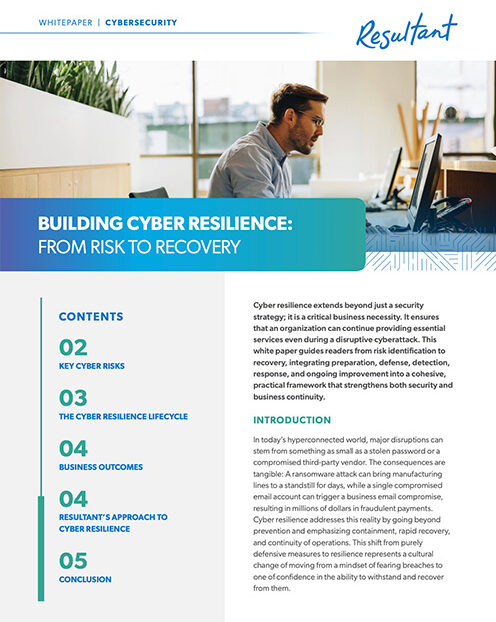Introduction
Key Cyber Risks
The Cyber Resilience Lifecycle
1. Understand Risk
The journey begins with knowing what matters most. A risk assessment not only identifies critical assets but also examines interdependencies, where an outage in one system could impact others. Threat modeling sessions bring together technical and business stakeholders to walk through realistic attack scenarios, ensuring defenses target areas with the most significant impact. Attack surface management provides a proactive approach, uncovering forgotten servers, misconfigured cloud resources, or exposed APIs before attackers can exploit them.
2. Strengthen Defenses
Building resilience requires reinforcing your environment in multiple layers. Multifactor authentication and role-based access control help keep identities secure, while modern email and endpoint protections block malicious attempts before they occur. Continuous monitoring yields actionable insights, enabling the detection of suspicious activity at an early stage. A disciplined vulnerability management process links patch cycles to business risk, ensuring the most critical weaknesses are fixed first, reducing exposure time.
3. Detect and Respond
When an incident occurs, speed is crucial. A 24/7 monitoring program staffed by experienced security analysts ensures that unusual activity, such as lateral movement or privilege escalation, is investigated within minutes, not days. Well-rehearsed playbooks guide teams through coordinated containment steps, from isolating infected devices to notifying leadership and other relevant stakeholders. Automation further speeds up the response, cutting off attacker access before damage can spread.
4. Recover with Confidence
True resilience is measured by how quickly an organization returns to its normal state of operation. Immutable backups and frequent restore tests give leaders confidence that critical data can be recovered without paying ransoms. Business continuity plans outline which services must be brought online first and what manual workarounds may be necessary during downtime. Post-incident reviews close the loop by identifying lessons that strengthen the environment against future attacks.
5. Continuous Improvement
Cyber resilience is an ongoing initiative. Every incident, near-miss, or tabletop exercise provides insights to improve our processes and overall program. Executive dashboards keep leaders updated by showing risk trends and investment needs. Our training and awareness programs stay current as threats change, making sure that both technology and personnel work together to protect the organization.
Business Outcomes
Resultant’s Approach to Cyber Resilience
Cyber Risk Management (CRM)
We begin by establishing a strong security foundation. Through detailed risk assessments, vulnerability scanning, and compliance benchmarking against frameworks such as NIST, HIPAA, PCI DSS, and CIS Controls, we provide organizations with a clear understanding of their security posture. Our CRM services and monthly cyber risk meetings provide ongoing, executive-level guidance for leadership. Additionally, Resultant assists clients in preparing for real-world incidents with incident readiness planning, tabletop exercises, and comprehensive policy development that align with regulatory and industry best practices.
Human Risk Management (HRM)
Recognizing that people are a significant source of breaches, we help organizations reduce employee-related risks. Resultant offers engaging awareness training tailored to specific roles and real-world threats such as phishing and credential theft. We reinforce learning through simulations and leadership engagement. This is supported by advanced email security, phishing prevention, and identity protection measures, including multifactor authentication, single sign-on, and identity governance, all designed to reduce opportunities for human error and insider threats.
Attack Surface Management (ASM)
To stay ahead of adversaries, Resultant continuously identifies, monitors, and remediates organizational exposures. We apply vulnerability management with risk-based prioritization informed by exploit likelihood and business impact. Our cloud security posture management provides ongoing oversight of misconfigurations and compliance gaps across dynamic environments. At the same time, penetration tests and controlled attack simulations uncover hidden attack paths and validate the effectiveness of our defenses.
Managed Detection and Response (MDR)
Resultant’s MDR services provide 24/7 monitoring, detection, and rapid response across systems, networks, endpoints, and cloud platforms. Our SOC analysts correlate alerts from throughout the enterprise, including email, IDS, firewalls, and EDR, to offer unified visibility. Through proactive threat hunting, automated initial response actions, and swift human-led containment, we prevent threats from spreading and contain them effectively. Each incident presents an opportunity to refine detection rules and playbooks, thereby continually enhancing defenses against future attacks.
Backup and Disaster Recovery (BDR)
We help organizations recover quickly and minimize downtime in the event of incidents. With immutable backups, disaster recovery planning, and proven restoration processes, Resultant enables clients to restore their operations confidently. Our approach focuses on critical systems, supporting both technical recovery and business continuity, turning potential crises into manageable disruptions.

